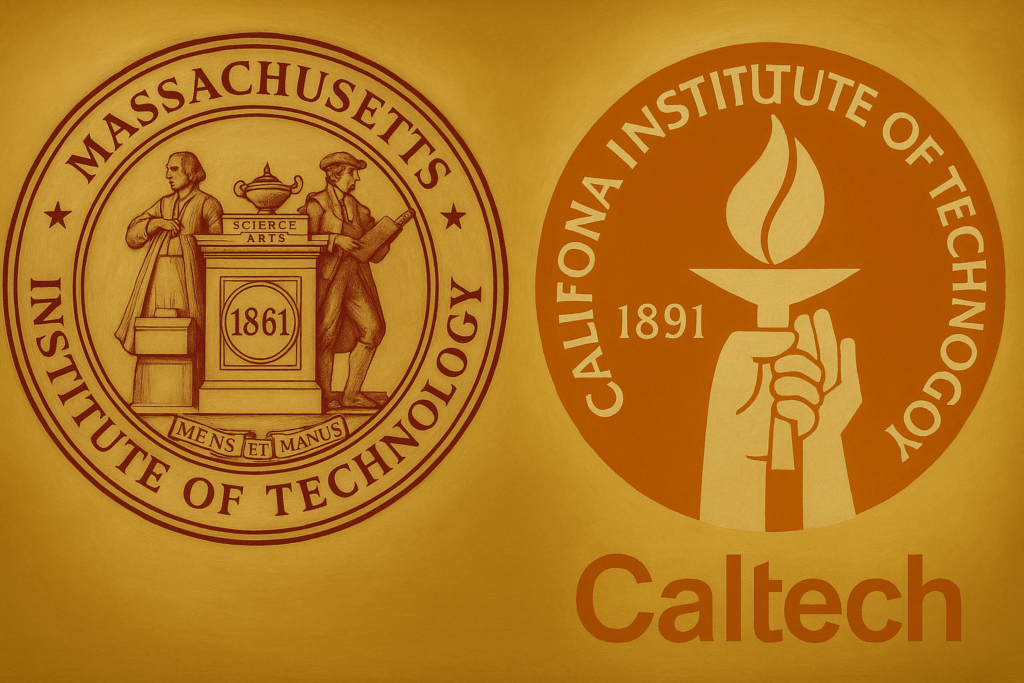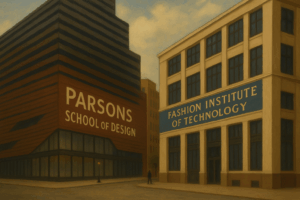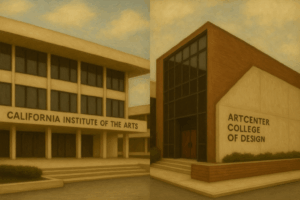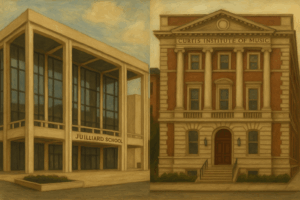
The GOAT of American STEM Universities?
When discussing the future of global science and technology, the Massachusetts Institute of Technology (MIT) and the California Institute of Technology (Caltech) are two indispensable names. They are more than just educational institutions; they are colossal engines at the forefront of human intellect, driving innovation and birthing ideas that define eras.
While many perceive the two schools as competitors pursuing similar goals, this is merely a surface-level observation. If MIT is an empire of ‘practical innovators’ born to meet the demands of the industrial age, Caltech is closer to an ‘intellectual sanctuary’ intentionally created to realize the ideals of pure science.
This article moves beyond the simplistic question of “Which university is better?” to embark on a journey to answer a more fundamental question: “Which environment and culture will unlock my potential?”
A Side-by-Side Look: 2025 Key Metrics Analysis
The first step to understanding the character of these two universities is to examine the objective data. These numbers intuitively show the fundamental differences in their scale, financial power, and educational environment.
| Metric (2024-2025) | MIT (Massachusetts Institute of Technology) | Caltech (California Institute of Technology) |
|---|---|---|
| US News 2025 Ranking (National) | 2nd | 6th |
| QS World University 2025 Ranking | 1st | 10th |
| Class of 2029 Acceptance Rate | 4.5% | ~2.3% (Class of 2028 data) |
| Total Students (2024-2025) | 11,886 (4,535 Undergrad / 7,351 Grad) | 2,430 (987 Undergrad / 1,443 Grad) |
| Student-to-Faculty Ratio | 3:1 | 3:1 |
| University Endowment (FY 2024) | $24.6 Billion | $4.3 Billion |
| Annual Tuition (2025-2026) | ~$61,990 | ~$63,402 |
The most striking point in this table is the stark difference in student population. MIT’s student body is nearly five times that of Caltech, suggesting a fundamentally different educational experience. MIT’s 3:1 student-faculty ratio symbolizes an ‘abundance of opportunity,’ while Caltech’s 3:1 ratio symbolizes the ‘density of relationships.’
Founding Narratives and Culture: Two Universities Forged in Different Flames
MIT: ‘Mind and Hand’ (Mens et Manus) for the Nation
MIT’s story can be summarized in two words: ‘practicality’ and ‘participation.’ The founder’s vision of a new educational institution that would contribute practically to the industrial age is encapsulated in the motto ‘Mens et Manus’ (Mind and Hand), which forms the bedrock of MIT’s educational philosophy of integrating theory and practice.
- IHTFP: Among MIT’s students, who share a love-hate relationship with their school, the acronym ‘IHTFP’ is dually used to mean “I Hate This Fucking Place” and “I Have Truly Found Paradise.” This succinctly captures the complex emotions at MIT—feeling intellectual ecstasy amidst the extreme pain of an immense workload.
- The ‘hack’ culture, which pushes the boundaries of rules, and the collaborative all-night problem-solving sessions (‘P-sets’) are symbols of the MIT spirit.
Caltech: A Journey Towards a Sanctuary of Pure Science
Caltech’s history is a narrative of ‘selection’ and ‘focus.’ In the early 20th century, three extraordinary scientists intentionally kept the school’s size small, selecting only the best talent to create an environment where they could focus solely on the most fundamental questions of science.
- The Honor Code: The Principle of Absolute Trust: “No member of the Caltech community shall take unfair advantage of any other member of the Caltech community.” Thanks to this single-sentence honor code, unproctored exams are possible at Caltech, and students have free access to research facilities 24/7.
- The eight unique ‘House’ systems and ‘Ditch Day,’ where seniors leave elaborate challenges for underclassmen, showcase Caltech’s unique community culture and intellectual playfulness.
Educational Philosophy and Innovation: Two Paths to Mastery
MIT: Broad Foundations and an Open Innovation Ecosystem
MIT requires all undergraduates to complete core subjects in math, physics, chemistry, and biology (General Institute Requirements, GIRs), ensuring they build a broad scientific foundation. The Undergraduate Research Opportunities Program (UROP) is a key system that realizes the ‘learning by doing’ philosophy, allowing students to develop the ability to apply theory to reality by participating in actual research.
This openness extends to the world-class innovation ecosystem next to campus, ‘Kendall Square,’ with MIT acting as the heart of a massive ‘innovation city.’
Caltech: Deep Theory and Grand-Scale Science Projects
Caltech’s education is characterized by uncompromising depth and intensity. All students complete an extremely demanding core curriculum, forming an identity as a ‘Techer’ who shares a deep understanding of the fundamental principles of science.
Caltech’s innovation is achieved by concentrating its capabilities on a few massive projects that expand the boundaries of human knowledge.
- NASA’s Jet Propulsion Laboratory (JPL): Leads numerous space exploration missions, including the Mars rovers.
- LIGO (Laser Interferometer Gravitational-Wave Observatory): The project that first detected the gravitational waves predicted by Einstein.
The Giants Who Led Human Intellect: A Comparison of Alumni Who Changed the World
Top 10 Notable Alumni Who Graced MIT
MIT alumni are characterized as ‘leaders who design systems and solve problems’ in diverse fields such as engineering, economics, politics, and culture.
| Name | Key Achievements and Influence |
|---|---|
| Richard Feynman | Nobel laureate in Physics, reformulated quantum electrodynamics, created ‘Feynman diagrams’. |
| Kofi Annan | 7th Secretary-General of the UN, Nobel Peace Prize laureate. |
| Buzz Aldrin | Apollo 11 lunar module pilot, the second human to walk on the moon. |
| William Hewlett | Co-founder of Hewlett-Packard (HP), a pioneer of Silicon Valley. |
| Ben Bernanke | 14th Chair of the U.S. Federal Reserve, played a crucial role in overcoming the 2008 financial crisis. |
| Drew Houston | Co-founder of the cloud storage service Dropbox. |
| Sal Khan | Founder of the non-profit educational platform ‘Khan Academy’. |
| Shirley Ann Jackson | First African American woman to earn a Ph.D. from MIT, theoretical physicist, former Chair of the U.S. Nuclear Regulatory Commission. |
| I. M. Pei | World-renowned architect who designed the Louvre Pyramid, among other structures. |
| Charles Koch | Chairman of Koch Industries, one of the world’s largest private companies. |
Top 10 Notable Alumni Who Graced Caltech
Caltech’s alumni are predominantly ‘pioneers who change the fundamental paradigms’ of specific scientific and technological fields.
| Name | Key Achievements and Influence |
|---|---|
| Linus Pauling | The only person to have been awarded two unshared Nobel Prizes (Chemistry and Peace). |
| William Shockley | Invented the transistor, winning the Nobel Prize in Physics and ushering in the modern electronics age. |
| Gordon Moore | Co-founder of Intel, originator of ‘Moore’s Law’. |
| Frank Borman | Commander of Apollo 8, the first human to orbit the Moon. |
| Arnold Beckman | Inventor of the pH meter, founder of Beckman Instruments. |
| Stephen Wolfram | Developer of the computation software Mathematica and the computational knowledge engine WolframAlpha. |
| Frances Arnold | Won the Nobel Prize in Chemistry for developing ‘directed evolution’. |
| Kip Thorne | Led the LIGO project to detect gravitational waves, winning the Nobel Prize in Physics. |
| Qian Xuesen | Co-founder of JPL, the ‘Father of Chinese Rocketry’. |
| Donald Knuth | The ‘father of the analysis of algorithms,’ author of the computer programming bible “The Art of Computer Programming.” |
Conclusion: Which is the Best Choice for You?
The choice between MIT and Caltech is not a matter of superiority, but a matter of ‘disposition’ and ‘vision.’
- MIT: The ‘Innovation Ecosystem’ for the Practical Leader
This is the ultimate choice for the ‘practical leader’ who dreams of ‘creating’ something new by fusing diverse fields, seizing opportunities within a vast innovation ecosystem, and solving the problems of complex systems. - Caltech: The ‘Intellectual Sanctuary’ for the Pure Scientist
This offers the optimal environment for the ‘pure scientist’ who wishes to walk a path of deep immersion in a single scientific question, feels joy in expanding the boundaries of human knowledge, and wants to pursue truth in a tight-knit community of extraordinary peers.
If MIT is the place that builds the ‘engines’ to solve the world’s problems, Caltech is the place that draws the ‘blueprints’ of the universe in which those engines operate. Where does your heart beat faster? Finding that answer is the true meaning of comparing these two great universities.


